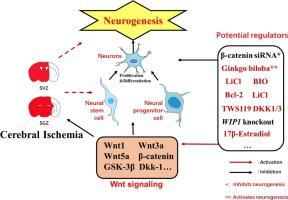Brain Research Bulletin ( IF 3.8 ) Pub Date : 2020-08-05 , DOI: 10.1016/j.brainresbull.2020.07.005 Dan Xu 1 , Fengyang Li 1 , Gou Xue 1 , Kai Hou 1 , Weirong Fang 1 , Yunman Li 1

|
Neurogenesis process in the chronic phase of ischemic stroke has become the focus of research on stroke treatment recently, mainly through the activation of related pathways to increase the differentiation of neural stem cells (NSCs) in the brain sub-ventricular zone (SVZ) and subgranular zone (SGZ) of hippocampal dentate gyrus (DG) areas into neurons, promoting neurogenesis. While there is still debate about the longevity of active adult neurogenesis in humans, the SVZ and SGZ have the capacity to upregulate neurogenesis in response to cerebral ischemia, which opens discussion about potential treatment strategies to harness this neuronal regenerative response. Wnt signaling pathway is one of the most important approaches potentially targeting on neurogenesis after cerebral ischemia, appropriate activation of which in NSCs may help to improve the sequelae of cerebral ischemia. Various therapeutic approaches are explored on preclinical stage to target endogenous neurogenesis induced by Wnt signaling after stroke onset. This article describes the composition of Wnt signaling pathway and the process of neurogenesis after cerebral ischemia, and emphatically introduces the recent studies on the mechanisms of this pathway for post-stroke neurogenesis and the therapeutic possibility of activating the pathway to improve neurogenesis after stroke.
中文翻译:

Wnt信号通路对脑缺血后神经再生的影响及其治疗潜力。
缺血性脑卒中慢性期的神经发生过程成为近期脑卒中治疗研究的热点,主要通过激活相关通路来增加脑室下区(SVZ)和颗粒下神经干细胞(NSCs)的分化。海马齿状回 (DG) 区的区 (SGZ) 进入神经元,促进神经发生。虽然关于人类活跃的成人神经发生的寿命仍有争议,但 SVZ 和 SGZ 有能力上调神经发生以应对脑缺血,这开启了关于利用这种神经元再生反应的潜在治疗策略的讨论。Wnt 信号通路是可能靶向脑缺血后神经发生的最重要途径之一,在NSCs中适当激活它可能有助于改善脑缺血的后遗症。在临床前阶段探索了各种治疗方法,以针对中风发作后 Wnt 信号诱导的内源性神经发生。本文介绍了Wnt信号通路的组成和脑缺血后神经发生的过程,重点介绍了近年来有关该通路对脑卒中后神经发生机制的研究以及激活该通路改善脑缺血后神经发生的治疗可能性。



























 京公网安备 11010802027423号
京公网安备 11010802027423号